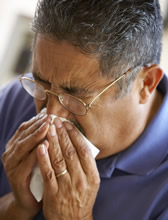H1N1 Influenza: Risk of Illness Among Healthcare Personnel

NIOSH Statement
Risk of Serious Illness Among Healthcare Personnel Associated With 2009 H1N1 Influenza:
What Is NIOSH Learning?
October 16, 2009
Reports in the news media have associated the deaths of at least four nurses with 2009 H1N1 influenza. Efforts to gain a fuller understanding of the prevalence of serious H1N1 illness and fatalities among nurses, as well as other healthcare personnel, have been limited due to a lack of occupational data in existing healthcare surveillance systems. More efforts are needed in order to fully appreciate the prevalence of severe H1N1 illness among healthcare workers.
NIOSH is working with its partners to gather more information about deaths and serious illness among healthcare personnel associated with 2009 H1N1 influenza. These surveillance activities are aimed at better understanding the factors that may heighten the risk of severe work-related 2009 H1N1 infection among healthcare personnel, as well as identifying the factors which affect risk of transmission of 2009 H1N1 influenza to healthcare personnel.
Healthcare personnel are at increased risk of occupational exposure to the 2009 H1N1 virus based on their likelihood for encountering patients with 2009 H1N1 illness. In contrast to seasonal influenza virus, 2009 H1N1 influenza virus has caused a greater relative burden of disease in younger people, which includes those in the age range of most healthcare personnel. For some healthcare personnel, this higher risk of exposure and illness may be compounded by the presence of underlying illness which places them at higher risk of serious flu complications, such as asthma, diabetes, or neuromuscular disease. Of particular concern to the healthcare workforce, which is largely female, is the fact that pregnant women are among those groups considered to be at higher risk of severe infection from 2009 H1N1.
As NIOSH gathers further information about the prevalence of serious illness among healthcare personnel, it recommends the following precautions, based on known risks of exposure for healthcare personnel and known risk factors for complications from influenza:
- Healthcare facilities should follow U.S. Centers for Disease Control and Prevention (CDC) interim guidance for 2009 H1N1 influenza infection control for healthcare personnel.
- Healthcare personnel should be encouraged to receive both the seasonal influenza vaccine and the 2009 H1N1 vaccine when available.
- Healthcare personnel should be informed about and aware of the types of underlying conditions that may put them at higher risk of complications. In addition to pregnant women, those at higher risk for complications of 2009 H1N1 influenza include the following: those with a variety of chronic medical conditions (examples include asthma, sickle cell disease, and diabetes mellitus); people with immunosuppression caused by medications or disease; those with disorders such as neuromuscular disease that compromise respiratory function or handling of respiratory secretions or increase the risk of aspiration; those younger than 19 years of age who are on chronic aspirin therapy; and those 65 years of age or older.
- Healthcare personnel should be informed about and aware of the or influenza-like illness, the emergency warning signs to seek urgent care, including but not limited to difficulty breathing, shortness of breath, or pain or pressure in the chest or abdomen, and the need to seek care aggressively if they have conditions that put them at higher risk of complications of influenza or if they have any concerns about their symptoms.
- Healthcare employers should have flexible, non-punitive, and well-communicated leave policies. They should allow personnel who have the flu to stay home and away from co-workers.
